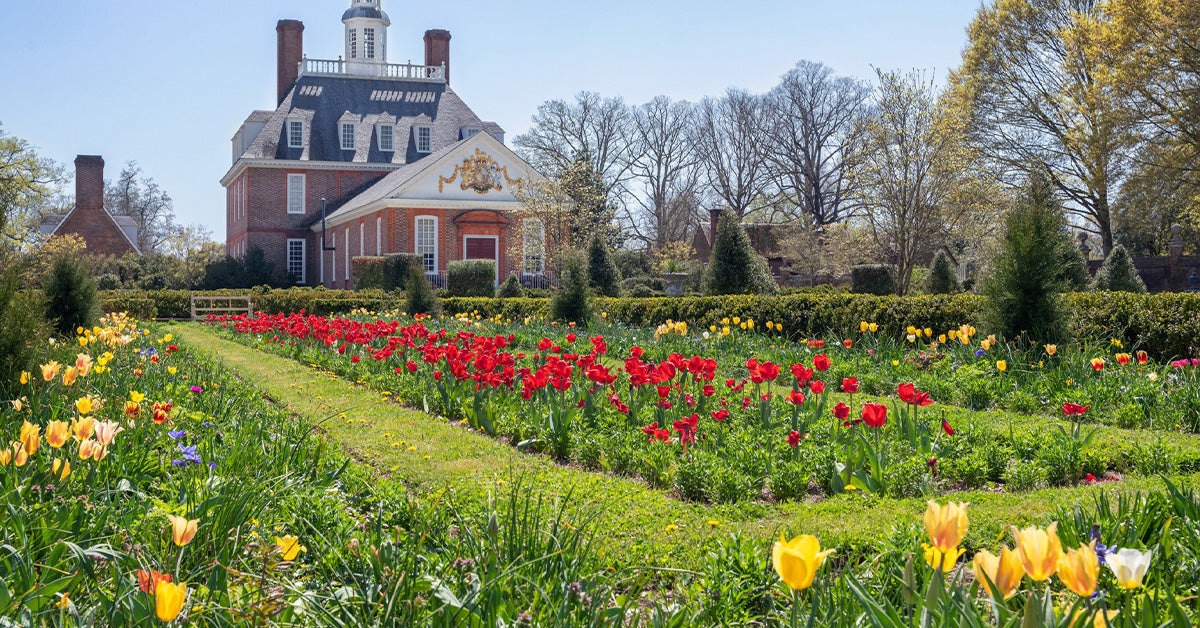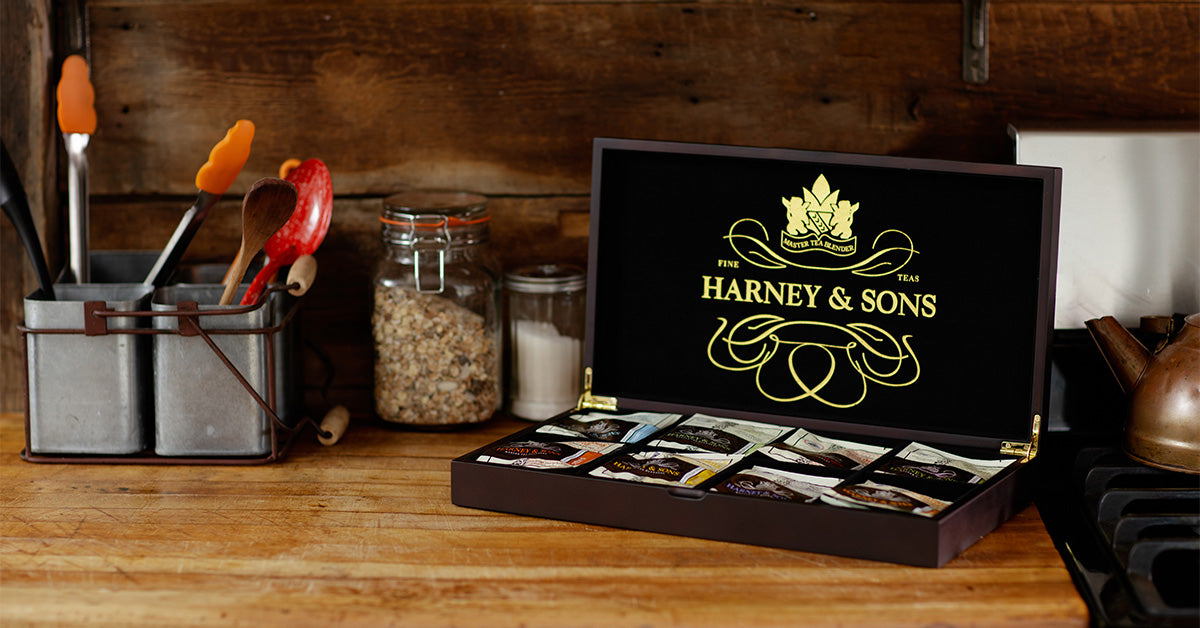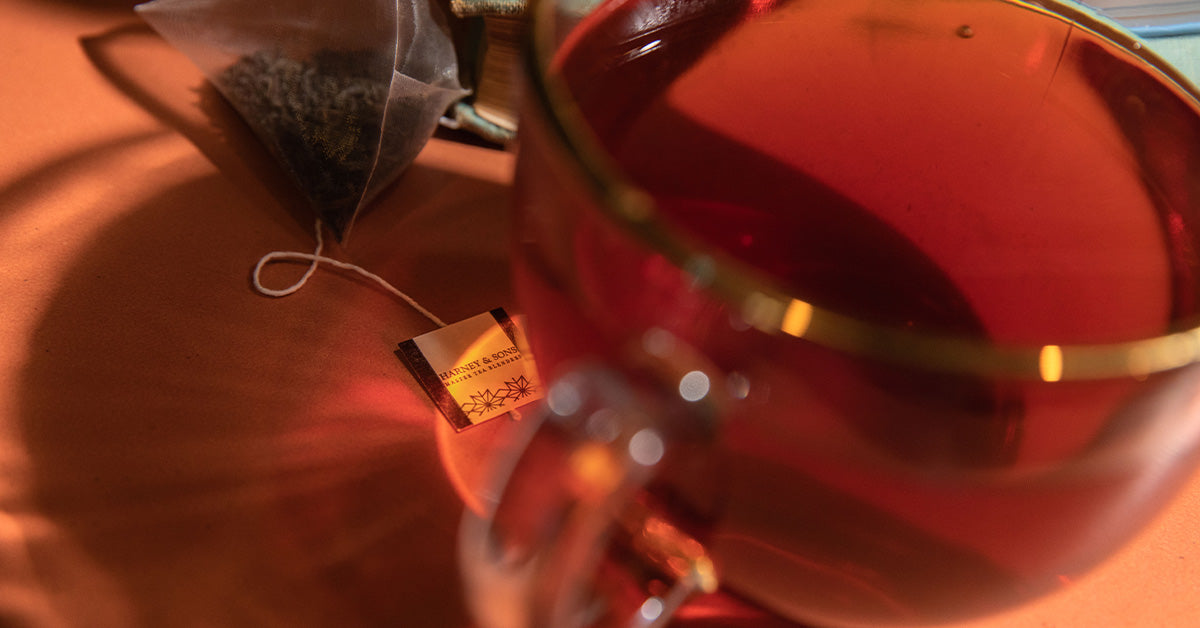
Fans of Colonial Williamsburg, rejoice! To kick off our 2023 “Tea Time” series, we talked tea and history with our friends at The Colonial Williamsburg Foundation. If you haven’t discovered our line of Colonial Williamsburg teas, we think after reading this, you’ll be sending in your order! And if you’ve never been to Colonial Williamsburg, a truly wonderful and uniquely American experience, we think you might be booking a trip as well.
Harney: Hello, Colonial Williamsburg! Please tell our readers who we’re talking with today and what your roles are at Williamsburg.
CW: Hi there! We’re Kiri, Liza, and Jillian, and we’re the team upholding the 85+ year legacy of WILLIAMSBURG, the licensed product brand of The Colonial Williamsburg Foundation.
Harney: Colonial Williamsburg is such a fascinating, important, and multi-layered topic. For those who aren’t familiar with Williamsburg and The Colonial Williamsburg Foundation, can you give us a quick overview of what Williamsburg is and its significance in U.S. history?
CW: Williamsburg, Virginia, presents a time capsule of 18th century life to discover and understand. The city is nestled between Jamestown - the 1607 colony famous for John Smith and Pocahontas - and Yorktown - where the final battle of the Revolutionary War took place. Williamsburg was the capital of Virginia from 1699 to 1780, meaning that it was the bustling seat of government for the entire colony during the time when the dream of American freedom and independence was taking shape.

Harney: The mission of The Colonial Williamsburg Foundation is “That the future may learn from the past.” When was the Foundation started, and why is preserving Williamsburg and telling its story important?
CW: The dream for Colonial Williamsburg started in the 1920s with Rev. Dr. W.A.R. Goodwin, rector of the historic Bruton Parish Church, recognizing that historically significant 18th century buildings were falling into sad disrepair. Goodwin shared his vision with philanthropist John D. Rockefeller, Jr., who signed on to aid and fund the restoration initiative. Our “living history museum” officially opened to the public in 1926 and has grown to include more than 300 acres, 89 original buildings, a world-class art museum, and more than 20 Historic Trades. Our Foundation continues to evolve, bringing history to life for new generations through careful research, conservation, and preservation and by providing immersive programming and authentic resources for learners, educators, and researchers throughout the world.
Harney: Approximately how many people visit Williamsburg every year, and what are its main attractions?
CW: We welcome over six million visitors annually to Williamsburg, Virginia, but since we opened our “doors,” over 65 million people have taken a step back in time with us. Guests love visiting the Governor’s Palace (the grandest building on our grounds), the Historic Trades shops (where artisans practice 18th century skills like weaving, blacksmithing, and carpentry), and our beautiful landscape dotted with parterre gardens, white picket fences, and lambs in the springtime! Visitors especially love visiting in December for our Grand Illumination celebrations when each house is decked with natural-material wreaths and candles are alight in each window. It’s truly a special experience and time of year.
Harney: There are no thrill rides or beloved characters/mascots in Colonial Williamsburg – is this a good place to take kids?
CW: Absolutely! Our young guests experience history all over town – from hands-on exploration of tools and materials in our Historic Trades shops to taking part in colonial games and dances. Colonial Williamsburg has crafted “itineraries” of sites and events for families and guests with specific interests; the “Jane Austen Lovers” itinerary holds our particular interest! And we might argue that there are beloved “characters” that wander around town – you’ll often see a young Martha and George Washington driving their carriage or the Marquis de Lafayette exercising his horse!

Harney: Do each of you have a favorite place in Williamsburg? If so, what and why?
Kiri: There are so many places that are amazing here, but I would say the taverns are a favorite for me. It’s so much fun to take friends, family, and business partners to experience The King’s Arms or Shield’s Tavern, or Christiana Campbell’s. Our taverns do an incredible job of curating authentic 18th-century meal offerings, and the interpreters and musicians complete that unique ambiance.
Liza: As a former Colonial Williamsburg curator who has done a lot of research on tea drinking in 18th-century Virginia, I particularly like the “Revolution in Taste” exhibit at the DeWitt Wallace Decorative Arts Museum, which features hundreds of British and Chinese export ceramic tea wares of the types used in 18th century England and America.
Jillian: I love visiting the gardens and grounds at the Governor’s Palace. When I walk the oyster shell path around the “canal,” away from the sounds of cars and buses, I’m completely transported and can imagine what it must have been like centuries ago.
Harney: What’s on the horizon for Williamsburg in 2023?
CW: The year 2023 promises to be an exciting time for The Colonial Williamsburg Foundation as we progress several important projects like the First Baptist Church and the American Indian Initiative toward our goal of researching, preserving, and interpreting the actual places where our nation’s ideals and principles took shape so that everyone can be inspired by the stories of people who forged a nation. We have a lot of history to tell, and we look forward to sharing these stories!
For WILLIAMSBURG Brand, we continue celebrating Colonial Williamsburg’s design legacy through our Designer in Residence program featuring interior design by Heather Chadduck Hillegas, recently showcased in the January/February issue of Veranda magazine. We’re also excited to launch a Magnolia Tree program later this year, offering individual gift trees grown from the oldest Southern Magnolia tree in Colonial Williamsburg. More information on both can be found on our website at williamsburgbrand.com.
Harney: We could talk about Williamsburg’s place in history and what it offers today for a long time, but we need to move on to other topics, mainly food, and tea! We know of three signature Williamsburg restaurant specialties. Let’s start with Chowning Tavern’s Root Beer. What’s so special about this root beer, and was root beer a colonial-times beverage? Also, for those not familiar, “Chowning” is pronounced “chewning,” correct?
CW: Root beers in the 18th century were likely alcoholic, according to our Master of Historic Foodways, Frank Clark. While there are some slight ingredient changes from the 18th-century version, the root beer we offer today is a non-alcoholic fan favorite!
The pronunciation of Chowning has long been debated; at one point, family descendants pronounced it “Chewnings,” but it seems other family members did not! But not to worry, they’ll respond to both pronunciations at the tavern.
Harney: Let’s move on to one of the most well-known dishes, King’s Arm Tavern’s Peanut Soup. Most people have never heard of peanut soup (which is delicious) – what are its origins?
CW: Our classic Peanut Soup is a more modern recipe but has become a tavern favorite. Based on research from Historic Foodways, the earliest recipes we find for peanut stews are in “The Carolina Housewife,” a cookbook collection dating back to the mid-1800s. These stews were often oyster-based stews with peanuts added to them. Our culinary teams crafted a modern take on the stew and even like to explore new flavors with the historic ingredient, as they did a few years ago with our first Revolutionary in Residence Michael W. Twitty, culinary historian, author, interpreter, and “Afroculinaria” blogger.

Harney: Finally, we have Raleigh Tavern’s Ginger Cake, which inspired one of our teas, the eponymously named Williamsburg Ginger Cake tea. What makes this dessert so special? How closely does our tea match the taste of the actual cake? (For our readers, you can get the recipe for these famous ginger cakes as well as other wonderful eats in the Raleigh Tavern Bakery cookbook included in our Williamsburg Duo & Cookbook Set.)
CW: The dessert is special because our guests have made it so! For years, visitors would seek out the Raleigh Tavern Bakery specifically for the ginger cakes. Historically, gingerbread dates to Germany in the 12th century, but we see a variety of ginger cake recipes through our 18th century cookbooks. These recipes produced something akin to what we know as a ginger snap. The ginger cakes that our visitors love is an airier version of this – thanks to modern leavening ingredients! No matter the form, ginger cakes remain a favorite, and we think our tea captures and celebrates that flavor!
Harney: That takes us to The Colonial Williamsburg Foundation partnership with Harney & Sons Fine Teas. We’re extremely proud of this partnership and happy to donate a portion of the proceeds of all our Williamsburg teas and gift sets to The Colonial Williamsburg Foundation. While we know the answer, could you share with our readers when our partnership began and how it came about?
CW: In 2020, when we decided to look for a tea company to collaborate with us, we knew Harney & Sons was our dream partner. We’ve always loved the unique blends Harney offers and admired their lines with other museums and historic sites. Luckily, our PR agent Michael McGraw is also a huge Harney fan and was able to make the connection. The rest is history – pun intended!

Harney: We’re so pleased to offer a few Williamsburg-inspired teas. In addition to our Williamsburg Ginger Cake tea, we also have Holiday Heritage, inspired by the Grand Illumination. Tell folks what the Grand Illumination is like, please, if it’s even possible to describe it in just words.
CW: Grand Illumination is an entirely magical time, beloved by guests as a kickoff to the holiday season. Not only do we set off fireworks above several of our sites, but the streets are also illuminated by cressets (metal baskets on a post with small campfires inside!) and our world-renowned Fire & Drum Corps playing through town, always followed by a large crowd of guests who like to join in their march. From musical events to memorable meals in our authentic Taverns, the sights, sounds and atmosphere make the experience completely unique.
Harney: We also created Williamsburg Summer Afternoon tea, which is reminiscent of an afternoon tea in a Southern garden. Is there a place where visitors can enjoy an afternoon garden tea in Williamsburg?
CW: We highly recommend pouring a cup of tea into a travel mug and venturing into one of our 30 picturesque gardens to sit for a spell. The charm of our historic town is the perfect setting for a soothing afternoon. If you’re looking for a more formal tea time, our five-star Williamsburg Inn often hosts special Afternoon Tea events; the next events are coming up around Valentine’s Day!

Harney: What role did tea play during colonial times?
CW: Tea was a controversial beverage! Tea came to Virginia from China, via England, in the early 18th century. By the mid-century, the tea party was the fashionable new entertainment ritual among Virginia’s gentry. We have oodles of teapots, cups, and “equipage” showcasing this tea obsession in our Dewitt Wallace Decorative Arts Museum. However, taxation of goods – specifically tea - shipped to the American colonies brought on the infamous Boston Tea Party of 1774 and eventually the Revolution. Patriots chose to rebel by drinking coffee or hot chocolate instead.
Harney: Are any of you tea drinkers? If so, what are your favorite teas (hopefully there’s a Harney tea or two on your list!)?
CW: Yes, all of us love tea! In fact, when developing our first tea with Harney & Sons (Holiday Heritage), we held a little tea tasting in our office to zero in on flavor profiles we wanted to explore through the collaboration! We are all fans of Harney’s Hot Cinnamon Spice tea, but also enjoy refreshing green tea blends.
Harney: Any Harney teas you’d like to try? Any Williamsburg treats you’d pair them with?
Kiri: I’m intrigued by the Pomegranate Oolong—I’d definitely like to try that (I love fruity teas.) The Garden Therapy Herbal Tea from The Met Collection also seems very relaxing and calming!
Liza: Paris! As we all know, Paris is always a good idea!
Jillian: As a young mom, I’ve been eyeing up the Mother’s Day blend, as well as the new Disney collaboration teas!
We are so pleased that The Colonial Williamsburg Foundation chose us to be their tea partner. The Foundation is doing an excellent job of preserving our history and making it come to life for generations to come, and that’s why a portion of every sale of our Williamsburg teas goes to the Foundation. Huge thanks to Kiri, Liza, and Jillian for taking the time to talk with us and provide such excellent information. All photography was provided by The Colonial Williamsburg Foundation.





3 comments
Arlene
Love the cinnamon spice,my favorite. Looking forward to trying the Williamsburg summer afternoon tea
Love the cinnamon spice,my favorite. Looking forward to trying the Williamsburg summer afternoon tea
Pat Thore Auton
Loved reading this article…..Paris is my absolute favorite blend! Interesting enough is where we first tasted this blend, in Bermuda! We were so shocked that the Harney Tea Company was located in the states…a wonderful discovery and it added to our Anniversary celebration! We keep this tea in supply at all times….thank you~
Loved reading this article…..Paris is my absolute favorite blend! Interesting enough is where we first tasted this blend, in Bermuda! We were so shocked that the Harney Tea Company was located in the states…a wonderful discovery and it added to our Anniversary celebration! We keep this tea in supply at all times….thank you~
Mary V
Harney’s teas are the very best – in quality as well as flavor!
Harney’s teas are the very best – in quality as well as flavor!